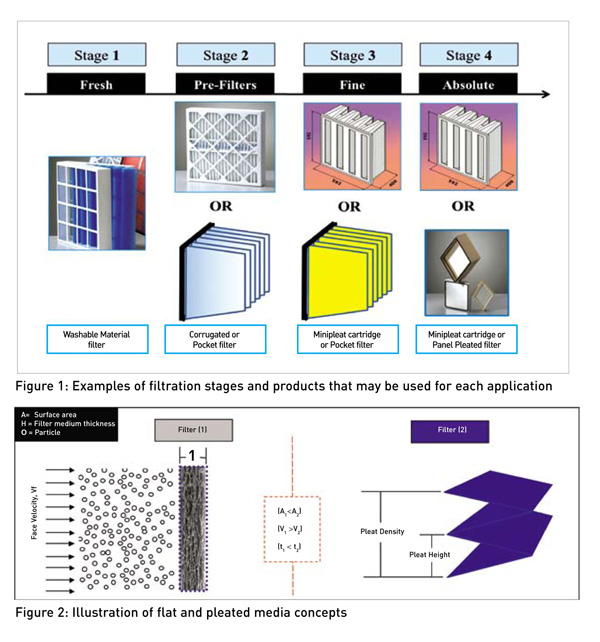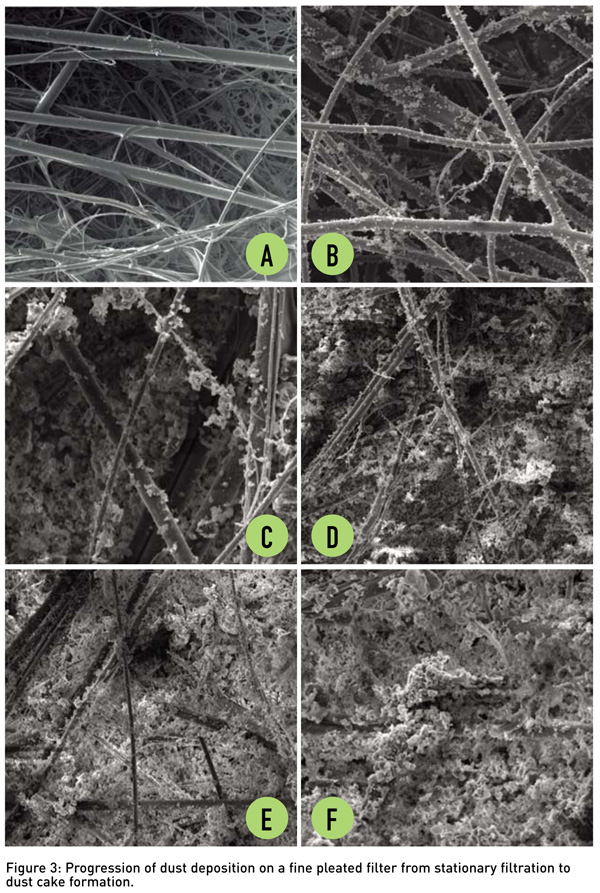In Part 12 of the series on air filtration, Dr. Iyad Al-Attar discusses the function of each filtration stage and the filter design required and also addresses underlying reasons that would make filter performance deviate from the laboratory test reports
Historically, air filtration has been a fascinating and vital engineering practice to many residential and industrial applications. Today, there is hardly any human, industrial, or scientific activity of any sort or scale that filtration is not an integrated part of its wellsprings. It is therefore, difficult to subsume it under any single engineering process.
Throughout the development of air filters, media and filter cartridge designers and manufacturers have competed to produce the best efficiency at the lowest air resistance. The rise of the pressure drop has always turned consultants away from choosing higher efficiencies for a specific application. Therefore, the market availability of aerodynamic and efficient filters will definitely be a game-changer in the field of air filtration.
Filter performance deviation
The available literature on air filtration field strongly demonstrates its complexity and simultaneous dynamic variation with several parameters. These parameters include face velocity, aerosol characteristics, filter medium properties, filter design, ambient conditions and dust types and their operating and loading conditions. Throughout the filtration research history, various assumptions were made in the literature in order to simplify the evaluation process of air filters. However, this evaluation can be viewed merely as a performance indication rather than exact filter performance. Furthermore, there are some parameters that are time-dependent such as mass loading, dust cake thickness, fibre shape, filter porosity, which leads to variation to the filter medium geometry due to particle deposition. All these factors, in addition to climate conditions and geographic location, participate in the air filter performance deviation from laboratory test reports.
Mechanical capture mechanisms
Mechanical capture mechanisms as referred by R.C. Brown (1993) are “the mechanisms that come into effect without the influence of attractive forces between the airborne particles and the filter fibre” [1]. As discussed in an earlier article of this series, these mechanisms are straining, impaction (I), interception (R) and diffusion (D) mechanisms. In gas filtration, it is common to assume that each mechanism acts independently of the rest. When evaluating the overall efficiency of a filter, the mechanisms considered are diffusion, interception and inertial impaction since they are the most important [2]. Several studies [2,3,4] approached the problem of assessing the overall efficiency when more than one collection mechanism is dominant. The total single fibre efficiency () then becomes the sum of the single fibre efficiencies of each individual mechanism to yield: =D+R+I .
The practice of simple addition of the individual filtration mechanisms is based on the assumption that only one mechanism is dominant, while the contributions of the other mechanisms are not significant. However, when absolute filters are assessed, the impaction mechanism effect is usually omitted as diffusion and interception are the two dominant mechanisms around the Most Penetrating Particle Size range (MPPS). The total single fibre efficiency () then becomes: =D+I .
It is important to realise that, while each capture mechanism effects are usually addressed separately, this by no means suggests they also act independently even if only one is dominant and, in fact, all mechanisms operate simultaneously [1]. In the case of impaction and interception and interception and diffusion mechanisms, some researchers have suggested that these mechanisms compete for the same particle and proposed a “combined effect” term to be added to the total single fibre efficiency equation.
Filtration stages
Clearly, filtration cannot be conducted by the solo performance of a single filtration stage. Therefore, it is absolutely imperative to select appropriately the filtration stages and choose the filters which would do the anticipated job. Filtration stages progress from Fresh to Pre and finally to Fine and Absolute. Higher surface area is required to achieve the required efficiency. There are several combinations of selection and the schematic in Figure 1 shows some examples but by no means covers all the available options in the market. There are two important aspects to highlight here: Improving particle residence time inside the filter medium and therefore increasing the effect of diffusional capture mechanism. This can be done by extending the filter surface area either by adding additional media pockets or by pleating the flat filter medium as shown in Figure 2 for Filters (1) and (2) respectively. In the same figure, the surface area (A) is extended to show A² > A1, which would lead to lower face velocity, that is V² < V1 and consequently the particle residence time inside the filter medium is higher, that is t2 > t1.
Filter Lifetime
Ideally, the entire lifetime of a depth filter goes progressively through the stage of stationary depth to non-stationary stage until particle surface deposition begins and dust cake formation occurs. The scanning electron microscopic images in Figure 3 illustrate the progression discussed.
To increase the probability of particles to deposit within the depth of filter medium, the particle size relative to the filter media pore size must be considered. However, we have to keep in mind several aspects:
1. One filter of F-grade [5] or Absolute class [6] cannot be used to deal with the entire particle size distribution of the atmospheric dust. By doing so, large particles will be strained on the surface of the high efficiency medium simply due to its particle size being larger the pore size. This will not allow the filter to act as a depth filter and surface deposition will take place. In other words, the depth filter would act as a surface filter. This is a not a good practice and defeats the intended operating objectives of utilising the entire filter depth. Therefore, Fresh and Prefilters are required to precede Fine and Absolute filters to allow each stage to deal with the appropriate particle size range relative to media pore size distribution.
2. Fresh air filters encounter the entire particle size distribution of atmospheric air, and therefore, particles might be collected by straining, impaction and interception. Pre-filters come after the fresh air stage and their main target is to avoid having the filter to strain its surface with particles. As far as the Fine and Absolute stages are concerned, it is not acceptable to strain particles at these two stages. In addition, the particle concentration reaching these stages, specifically the Absolute filters, are expected to be very low.
The atmospheric aerosol
The atmospheric aerosol consists of particle emitted from both natural and anthropogenic sources, which refer to those emitted by human activities [2]. Examples of natural sources are: sand storms, volcanoes, forest, and sea spray. The dynamic mixture of solid and liquid particles emitted from sources contributes to the variation of the atmospheric air. Therefore, it is difficult to generalise the physical and chemical characterisation of the atmospheric air as it may vary depending on the geographic location and human activities surrounding it. The particle size distribution of the atmospheric air challenging the fresh air filters varies in terms of contaminant number and concentration. Therefore, it is not at all surprising that the laboratory test results cannot be fully representative of the filtration of regional atmospheric dust. It is also fair to highlight that, for example, the elevated dust concentrations in Arabian Peninsula during sand storms are so extreme that they may not be attainable in testing an industrial scale filter in a laboratory setting.
To facilitate a real time filter performance assessment for the regional ambient conditions considering aerosol characteristics, climate and operating conditions, it is suggested that a mobile air filtration testing facility is designed, constructed and used. This facility will enable real time testing using actual atmospheric aerosol without having to accelerate testing in a laboratory setting. The mobility of the testing facility will help examine the effect of aerosol characteristics for different locations, which is important in our Gulf region, due to the widely varying dust types and atmospheric loadings conditions (owing to frequent periods of high winds). It could also be a useful tool to measure filter performance in industrial areas and assess dust concentration and dust types and other contaminants. A research mobile unit of such capabilities would greatly help in better understanding the filter performance and in making appropriate and suitable air filtration selection for each application.
Zooming out
Dust removal seems to immediately hover in our minds whenever the topic of air filtration is addressed, as if it is the only harmful contaminant existing in the atmosphere. Minor or no emphases are placed on other contaminants such as radon, soot, carbonaceous particles, and gashouses contaminants among many other contaminants that exist in the atmospheric air. Quite simply, we ought to zoom out to gain a wider perspective of the contaminants surrounding us that would require both thorough characterisation and in-depth analysis to make educated filtration decisions in choosing the required filtration solutions.
The writer is Regional Director, Middle East, and International Consultant, EMW Filtertechnik, Germany. He can be contacted at iyad.al-attar@emw.de
References:
[1] Brown R.C. 1993. “Air filtration: an integrated approach to the theory and application of fibrous filters”, Pergamum Press, Oxford.
[2] Hinds W.C., 1998. “Aerosol Technology”, Wiley, New York.
[3] Lee K.W., and Liu B.Y.H., 1982. “Experimental study of filtration by fibrous filters”, Aerosol Sci. Technol.,1(1), 35-46.
[4] Ramarao B.V., Tien C. and Mohan S., 1994. “Calculation of single fiber efficiencies for interception and impaction with superposed Brownian motion”, J. Aerosol Sci., 25(2), 295-313.
[5] EN 779:1993, Particulate air filters for general ventilation; requirements, testing, marking
[6] DIN 1822-1, 1998. “High efficiency air filters (HEPA and ULPA)” – Part 1: Classification, performance testing, marking.


Copyright © 2006-2025 - CPI Industry. All rights reserved.